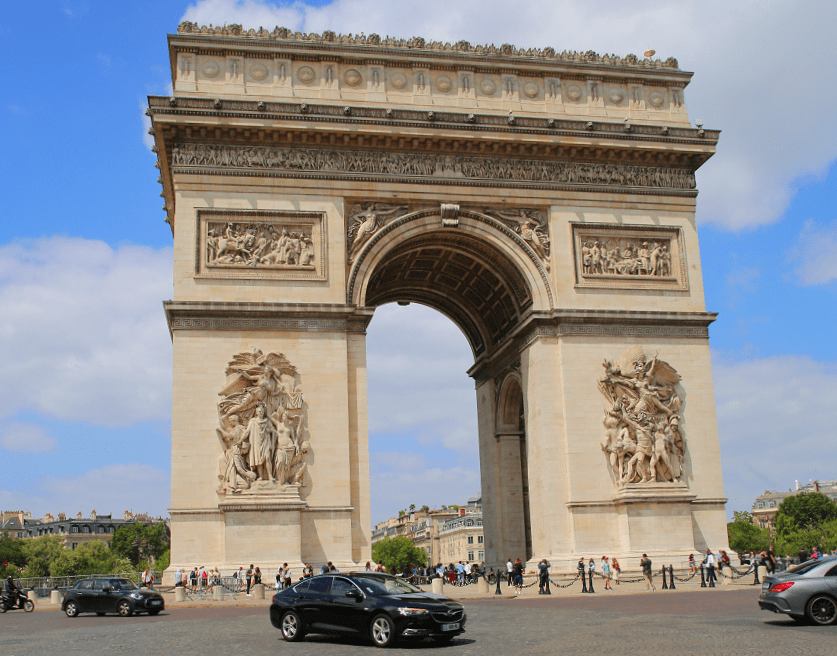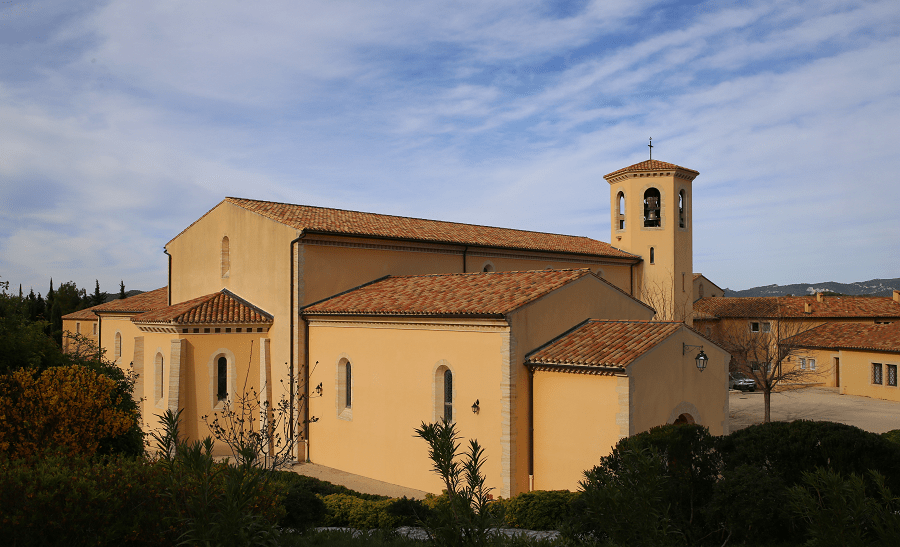The Arc de Triomphe de l’Étoile, often simply called the Arc de Triomphe, is a tetrapyl-type monument located in Paris (France), at a high point at the junction of the territories of the 8th, 16th and 17th arrondissements, notably at the top of the avenue des Champs-Élysées and the avenue de la Grande-Armée, which constitute a major east-west Parisian axis starting from the Louvre pyramid, passing by the obelisk of La Concorde square, the Arc de Triomphe itself even and ending in the distance with the Arch de la Défense. Its construction, promoted by Emperor Napoleon I, began in 1806 and was completed in 1836 under the reign of Louis-Philippe.
History
The Arc de Triomphe is located on the right bank of the Seine at the centre of a dodecagonal configuration of twelve radiating avenues. It was commissioned in 1806, after the victory at Austerlitz by Emperor Napoleon at the peak of his fortunes. Laying the foundations alone took two years and, in 1810, when Napoleon entered Paris from the west with his new bride, Archduchess Marie-Louise of Austria, he had a wooden mock-up of the completed arch constructed. The architect, Jean Chalgrin, died in 1811 and the work was taken over by Jean-Nicolas Huyot.
During the Bourbon Restoration, construction was halted, and it would not be completed until the reign of King Louis-Philippe, between 1833 and 1836, by the architects Goust, then Huyot, under the direction of Héricart de Thury. The final cost was reported at about 10,000,000 francs (equivalent to an estimated €65 million or $75 million in 2020).
On 15 December 1840, brought back to France from Saint Helena, Napoleon’s remains passed under it on their way to the Emperor’s final resting place at Les Invalides. Before burial in the Panthéon, the body of Victor Hugo was displayed under the Arc on the night of 22 May 1885.
Design
The astylar design is by Jean Chalgrin (1739–1811), in the Neoclassical version of ancient Roman architecture. Major academic sculptors of France are represented in the sculpture of the Arc de Triomphe: Jean-Pierre Cortot; François Rude; Antoine Étex; James Pradier and Philippe Joseph Henri Lemaire.
The main sculptures are not integral friezes but are treated as independent trophies applied to the vast ashlar masonry masses, not unlike the gilt-bronze appliqués on Empire furniture. The four sculptural groups at the base of the Arc are The Triumph of 1810 (Cortot), Resistance and Peace (both by Antoine Étex), and the most renowned of them all, Departure of the Volunteers of 1792 commonly called La Marseillaise (François Rude).
The face of the allegorical representation of France calling forth her people on this last was used as the belt buckle for the honorary rank of Marshal of France. Since the fall of Napoleon (1815), the sculpture representing Peace is interpreted as commemorating the Peace of 1815.
In the attic above the richly sculptured frieze of soldiers are 30 shields engraved with the names of major French victories in the French Revolution and Napoleonic wars. The inside walls of the monument list the names of 660 people, among which are 558 French generals of the First French Empire; The names of those generals killed in battle are underlined. Also inscribed, on the shorter sides of the four supporting columns, are the names of the major French victories in the Napoleonic Wars. The battles that took place in the period between the departure of Napoleon from Elba to his final defeat at Waterloo are not included.
For four years from 1882 to 1886, a monumental sculpture by Alexandre Falguière topped the arch. Titled Le triomphe de la Révolution (“The Triumph of the Revolution”), it depicted a chariot drawn by horses preparing “to crush Anarchy and Despotism”.
Inside the monument, a permanent exhibition, conceived by artist Maurice Benayoun and architect Christophe Girault, opened in February 2007.
Transport accessibility
The Arc de Triomphe is accessible by the RER and Paris Métro, with exit at the Charles de Gaulle–Étoile station. Because of heavy traffic on the roundabout of which the Arc is the centre, it is recommended that pedestrians use one of two underpasses located at the Champs Élysées and the Avenue de la Grande Armée. A lift will take visitors almost to the top – to the attic, where a small museum contains large models of the Arc and tells its story from the time of its construction. Another 40 steps remain to climb to reach the top, the terrasse, from where one can enjoy a panoramic view of Paris.
Address: Pl. Charles de Gaulle, 75008 Paris, France.
Working hours
Sunday 10 AM–10:15 PM
Monday 10 AM–10:15 PM
Tuesday 10 AM–10:15 PM
Wednesday 10 AM–10:15 PM
Thursday 10 AM–10:15 PM
Friday 10 AM–10:15 PM
Saturday 10 AM–10:15 PM
Phone: +33 1 55 37 73 77
Main facts
Construction started: August 15, 1806
Opened: July 29, 1836
Architects: Jean Chalgrin, Louis-Robert Goust, Jean-Nicolas Huyot, Guillaume-Abel Blouet, Jean-Arnaud Raymond
Height: 50 m
Architectural style: Neoclassical architecture
Owner: Centre des monuments nationaux
See more:

















